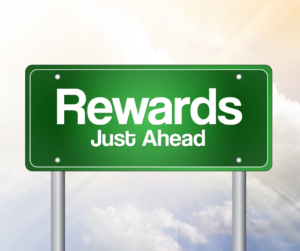 Winning teams love to celebrate. We’ve all been involved with companies that have “employee of the year” awards or other annual rewards. Whether or not these are actually rewarding and motivating depends on how the recipients are chosen and the awards administered. A big part of making rewards successful is rewarding what deserves to be rewarded. You’ll need to decide, consistent with your vision and culture, what is part of someone’s job (the minimum they have to do to get paid) and what is something more that deserves recognition. This can be a very fine line. If you recognize an “employee of the month” and one month you give it to someone simply because they haven’t ever received it or because no one else really did anything outstanding, you’ve just gutted the value of the award. If one of your values is integrity or authenticity, and you do this, you have now violated a core value. Much better not to give the award when no one has actually earned it.
Winning teams love to celebrate. We’ve all been involved with companies that have “employee of the year” awards or other annual rewards. Whether or not these are actually rewarding and motivating depends on how the recipients are chosen and the awards administered. A big part of making rewards successful is rewarding what deserves to be rewarded. You’ll need to decide, consistent with your vision and culture, what is part of someone’s job (the minimum they have to do to get paid) and what is something more that deserves recognition. This can be a very fine line. If you recognize an “employee of the month” and one month you give it to someone simply because they haven’t ever received it or because no one else really did anything outstanding, you’ve just gutted the value of the award. If one of your values is integrity or authenticity, and you do this, you have now violated a core value. Much better not to give the award when no one has actually earned it.
One program I’ve seen work successfully is a rewards program where employees hand out tickets to each other for whatever it is you want to encourage (this is sometimes called a “WOW” program). Each month, the employee with the most tickets gets half a day off. This can be a very inexpensive and effective motivational program that also builds awareness and good will amongst your employees. You could even tailor this around your company values, where employees could give out tickets every time someone did an outstanding job living the company values (they should all already be living them, so make sure it’s above and beyond).
However, you choose to celebrate wins, start by determining what’s most important to your employees and develop the program around that. Remember that one size doesn’t fit all. For example, a design firm chose to reward hours completed on time for each contract. Each designer was awarded hours that accrued on a chart all year. Anyone who reached a certain number of on-time billable hours (meaning within the project scope and deadlines) could earn a trip to Italy. The company made a huge chart with planes and destinations to put in the conference room so they had a visual at all times of where everyone was on their “journey.” Some employees complained that they didn’t have as many opportunities to earn hours as others, to which the CEO responded: “Make yourself an opportunity.” And they did. The majority of the team was able to earn the trip. While the contest aspect rewarded individual performance, the company acknowledged the importance of the team by inviting everyone who didn’t earn the trip to go at their own expense. Some did.
My favorite incentive was by a Seattle manufacturer and distributor of tchotchkes. After the company had achieved an incredible sales hurdle—a real stretch goal—the CEO decided to reward everyone in the company. He chartered two buses and drove all the employees to the mall. Once there, he gave them each $200 in cash. The rules were: they had one hour to spend it; they could not spend it on someone else; and they couldn’t save it. After an hour everyone boarded the buses and returned to the office where they showed their items and told why they had bought them. Afterward, they had a pizza party. This adventure did so much for company spirit during a difficult time that it became an annual event that produced great results in both morale and productivity. Not surprisingly, one of this company’s values was fun, which they certainly demonstrated through this exercise.
To sum up, the key to success with any reward program is that it contains the following elements:
- The reward is appropriate to the desired behavior.
- The program rewards both individual and team goals.
- The rewards are in alignment with company values.
- The behavior being rewarded is in alignment with overall company goals.
- The program is clearly defined and measurable.
- The program changes so it doesn’t lose value.
- The program is not set up as a popularity contest.
- There are both structured and random elements.
- Families are included in annual programs because your employees need support from home to give extra hours.
- The recognition feels positive to the individual employee (not everyone likes to get up in front of a crowd).
- The program is creative, visible, and fun!
Excerpted from my book, “Putting Together the Entrepreneurial Puzzle: The Ten Pieces Every Business Needs to Succeed.” Available here on Amazon.
